|
MRS O. F. WALTON'S ACCOUNT OF DAISY BANK
Mrs. Walton's "The Lost Clue" was published, by
the Religious Tract Society, in 1907. So the account of Daisy
Bank which it contains was probably based on experience of the area
at the turn of the century. Up to the time she moved to
Wolverhampton, there was nothing in Mrs. Walton's life which
suggests that she would have had any experience of this sort of
industrialised area; and it may therefore be that her description of
the area is more dark and drastic than the reality justified.
But there must be substantial truth in it.
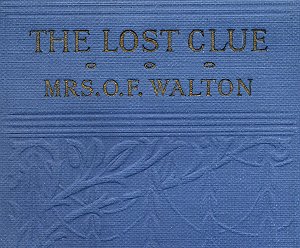
Part of the cover of The Lost
Clue.
Our heroine,
Marjorie Douglas, lives in the Lake District, in Borrowdale.
As the result of the sort of financial misfortune that was common to
Victorian heroines, she needs to find a job. Seeing an advert
for a mother’s help in Daisy Bank, Staffordshire, and thinking that
the place sounded very pleasant, Marjorie applies for the job, gets
it and travels to Daisy Bank by train, changing stations at
Wolverhampton. When she arrives at Daisy Bank station, late in
the evening, she is met by the twelve year old daughter of the
Holtby household, Patty:
|
“Are
you Miss Douglas?”
“Yes, I am. Have you come to meet me?”
“Yes. You're to leave your box at the station, and
father will send for it.”
“Can't I get a cab?”
The girl laughed. “Cab!” she said. “I should think not !
We've no cabs here.”
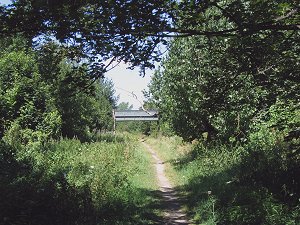 |
The site of the
railway cutting and Daisy Bank station
to-day. This part is now a linear park
but the rest of the cutting has been filled
in. |
They
left the box in the care of the porter, and the girl led
the way to a steep flight of stone steps leading to the
road above. Then she went along a roughly made cinder
path, and Marjorie followed a little behind, at times
plunging into great pools of water which she could not
see in the dim light, and at other times almost falling
on the slippery mud. Then they turned into a short
street, if street it could be called. It was so
irregular that it seemed to Marjorie as if houses of all
kinds had been thrown down there, and left to find their
own level and own position. They passed one or two
squalid shops, which appeared to sell little besides
shrivelled oranges and the commonest of cheap sweets.
| Part of the
cutting, south of the Great Western pub, now
filled in. |
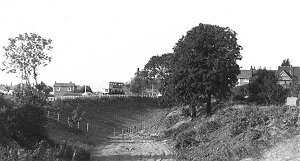 |
As
they walked on together the street lamps became fewer,
with long stretches of darkness between them, and at
length the furnace lights formed the only illumination,
and these every here and there revealed a scene of utter
desolation.
“What a curious place!” Marjorie said to the girl at her
side.
“I should just think it is,” she answered. “I hate it,
and mother does too!”
“Why do you live here, then?”
“Oh ! Father is the manager at the works over there. We
have to live here, I suppose; it's a hateful place!”
“Where are we going now?” asked Marjorie, as they seemed
to be leaving the road and turning into the darkness.
“Oh, it's a short cut over the mounds. Take hold of my
arm; you can't see, and you'll be walking off into one
of the pit‑pools. The lakes we call them,” she added,
with a laugh. “You come from the Lakes, don't
you?”
“Yes, from such a lovely place.”
“Well, you won't like our lakes, I'm afraid. They're
only rainwater that lies in the hollows between the
mounds. There are plenty of them about here.'
“Isn't it better to keep to the road such a dark night
as this?”
“You can't,” said Patty, “it's all deep mud; you'd stick
fast if you tried.”
At
length they saw a light, which came from the windows of
a square stone house with a small garden in front of it,
and Patty took a latch‑key from her pocket and opened
the door. Immediately a rush was heard from an inner
room, and six children of various ages ran out to see
the newcomer. |
Our heroine immediately sets about her work of
putting the house and the household to rights. This takes her
a day or two. Then:
|
That
afternoon Mrs. Holtby insisted on Marjorie's going out
for an hour or two, that she might get some fresh air
after her hard work.
So
far Marjorie had seen practically nothing of Daisy Bank,
for it was too dark the night before for her to do more
than see the dim outline of what she passed, and from
the windows of Colwyn House there was merely a narrow
view, shut in by houses on either side. She had not
expected to see much to charm her during her walk, but
she was hardly prepared for the scene of utter
desolation that met her eyes as she went down the muddy
lane leading from the house.
On
one side of it were a few tumble‑down cottages, damp and
discoloured; on the other was an open waste, strewn with
the remains of old furnace heaps. She looked across this
wilderness to the huge pit‑mounds, rising in all
directions, the very picture of gloom and dreariness.
Finding that the lane was still impassable from the
depth of mud, she turned upon the waste common, parts of
which were covered with thin, smoke‑begrimed grass. Here
there stood two old houses, even more wretched and
forlorn than those she had already passed. The bedroom
window of one was partly blocked with wood, and the room
was given up to pigeons, which flew in and out at
pleasure. The door of the other house was open, and she
saw a cock and a hen and three fat ducks walking about
as if the whole place belonged to them.
| The book contains
a brief reference to the fact that the
children go to school. Marjorie is
surprised that there is a school at all; but
she is told that there is an it is quite a
big one. This is Daisy Bank school,
still as it was in those times but now used
as a library and community centre. The
city council proposes to demolish it and
replace it with a modern version. |
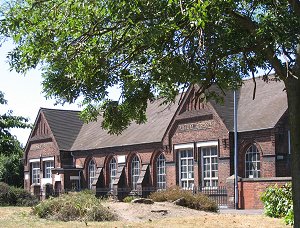 |
Further on she came upon two ragged women, down on their
knees upon an old mound, raking over the muddy ashes,
and picking out the wet and dirty cinders which were to
be found amongst them, and then stowing them away in an
old sack.
“What are you doing?” Marjorie asked.
“Getting cinders for the fire.”
“Will they burn?” she asked in astonishment.
“Yes, with a little coal. It's better than no fire at
all.”
Marjorie walked on, sick at heart, as she thought of the
kind of homes that those women must have. The cold, icy
wind was blowing in her face, and she shivered as she
thought of the apology for a fire which would be kindled
with those lifeless cinders.
After this she passed more houses and more mounds; but
nowhere in the whole place did she see a vestige of
anything whatever that was pleasant to look upon, The
houses were destitute of paint, the doors and
window‑frames were bare and unsightly, the numberless
broken panes were filled in with rag or paper. More than
one of the houses was in ruins ‑ every window broken,
and the walls ready to fall in. The mines below had
caused these houses to sink; they had been pronounced
unsafe, and had been left deserted, but no one had taken
the trouble to clear away the ugly, dismal ruins. There
they stood, blackened with furnace smoke, unsightly and
melancholy objects.
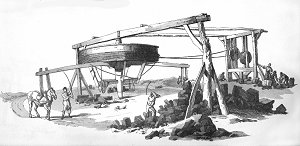 |
A
mine with a "heavy wooden frame and great
wheel"". Drawn in 1808 but used in the
Daisy Bank area and the rest of the Black
Country coal mining area until all mining
stopped. |
Only
two coal‑pits were working, so a man told her, who was
smoking a dirty clay pipe at his door. Some had stopped
because of bad trade; some were worked out; some had
filled with water, and were therefore abandoned. Yet at
the mouth of each of these deserted pits the heavy
wooden frame and great wheel still remained ‑ a gloomy
memento of more prosperous days. In every direction in
which she looked Marjorie saw unmistakable marks of
squalid, cheerless poverty; the only prosperous‑looking
building being the public house at the corner, which
appeared to do a thriving trade. The whole country was
honeycombed with mines, and, in consequence, many of the
houses had sunk below the level of the others in the
same row. Everything in Daisy Bank seemed crooked and
out of shape. Other cottages were scattered amongst the
furnace debris, were built anywhere and everywhere that
a place could be found for them, on different levels and
in sundry nooks and corners of the hilly waste.
| The Great Western
pub, originally the Great Western Hotel,
built on the main road near Daisy Bank
Station. Still a popular pub it serves
what is now an almost entirely residential
area, with few signs of the old industries
and their waste tips. |
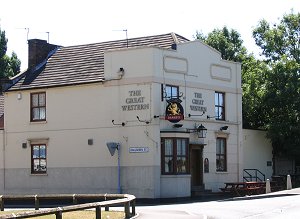 |
Then
she came to higher mounds still, and crossing these she
saw deep, black pools in their hollows, stretches of
dark, stagnant water, which never reflected anything
that was pretty or bright except the moon in God's pure
heaven above. Here and there some one, more thrifty than
his neighbours, had made a little garden in the waste;
but what could grow in such a smoky atmosphere and in
such poor and barren soil? A few struggling plants of
the most hardy kinds were all that the best garden in
Daisy Bank could produce.
Marjorie was glad to get back even to the dismal house
in which her lot was cast; it seemed almost cheerful to
her after the unkempt hideousness of its depressing
surroundings. |
Somewhat later
Marjorie visits a poor and invalid old lady (for whom, of course,
she does good works, and who, therefore, turns out to hold "the lost
clue" which turns round the fortunes of Marjorie's boy friend and
thus of herself. Mrs. Walton, at this stage in her writing
career, does not hammer the point that this is God's reward for
Marjorie's Christian good works but the moral is clearly there).
A part of their first conversation tells us more about the Daisy
Bank area:
“What a large house
you have, Mrs. Hotchkiss!”
“Too large!” groaned the old woman; “it used to be a
farm”.
“A farm here!” exclaimed Marjorie.
“Yes, long ago, in the old time when they hadn’t found
coal; it was all country here then”. |
That is an accurate account. The field
pattern shown on old maps seems to indicate that farming continued
there long enough for the fields to have been enclosed.
There is one other passage about Daisy Bank -
which provides an interesting guess about the origin of the name.
| Daisy Bank did not
alter much with the changing seasons: there was very
little to mark the progression of spring, summer, and
autumn. Barely a tree was in sight, and the few that
were to be found were so stunted, blighted, and covered
with smoke that the spring freshness of their leaves
lasted but a few days. Upon the mounds grew a few coarse
daisies ‑ at least, the children called them daisies;
they were a kind of feverfew with a daisy‑like flower.
Nothing else would grow there, which is perhaps why the
place got its name, a name which had at first appeared
to Marjorie to be utterly unsuitable. |
There seems to
be no reason to doubt that Mrs. Walton has provided us with an
accurate enough picture of Daisy Bank at the end of the nineteenth
century. It is, perhaps, more true to life than the
story to which it is a backdrop. In the novel Marjorie’s life
crosses and re-crosses that of a Captain Fortescue, who, as a result
of the sort of financial misfortune that was common to Victorian
heroes, had become almost penniless. But by a series of
incredible coincidences he is restored to his rightful position and
marries Marjorie, who finds herself to be Lady Derwentwater and
incredibly rich - a very proper outcome for such a good and godly
girl.
|





